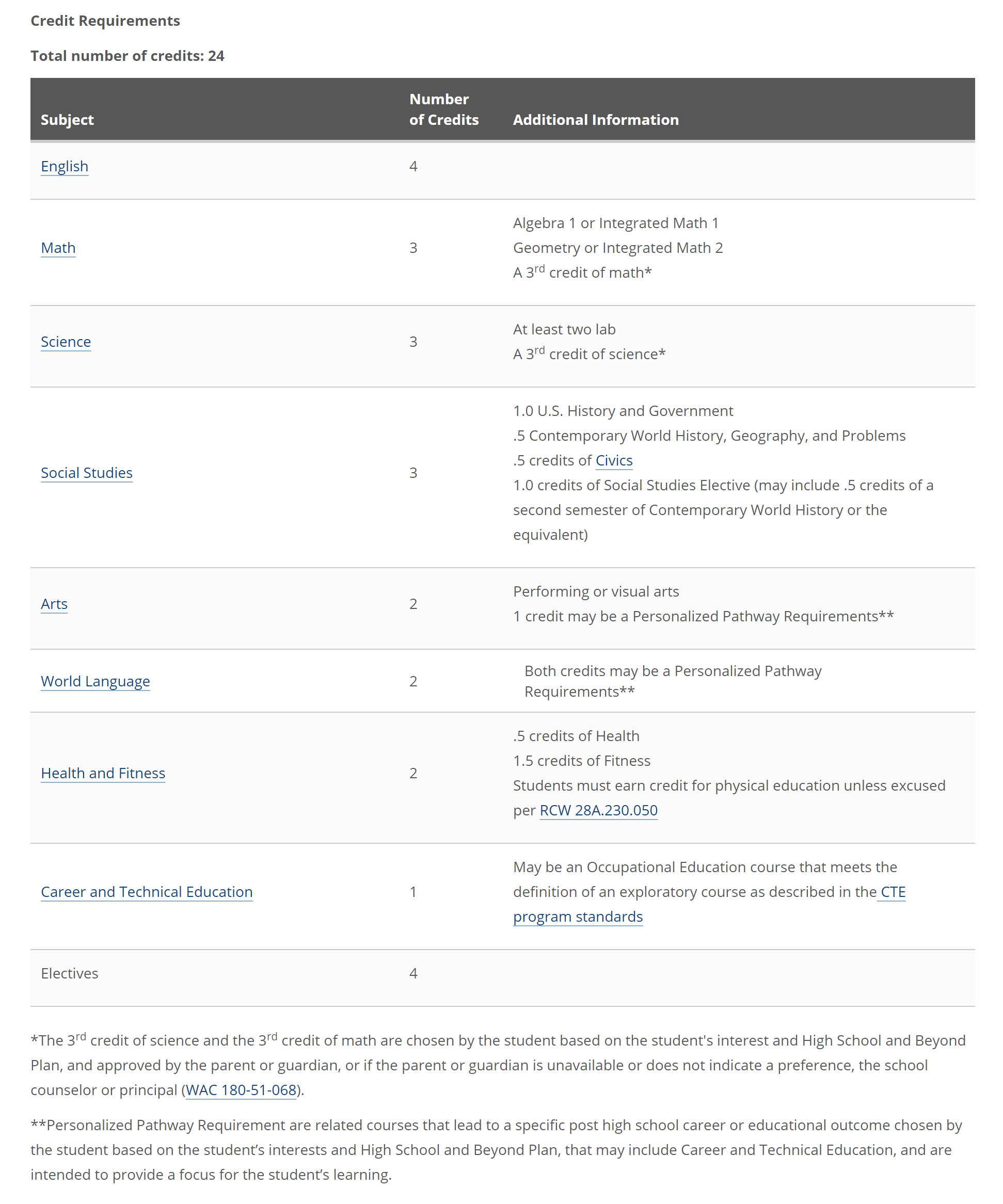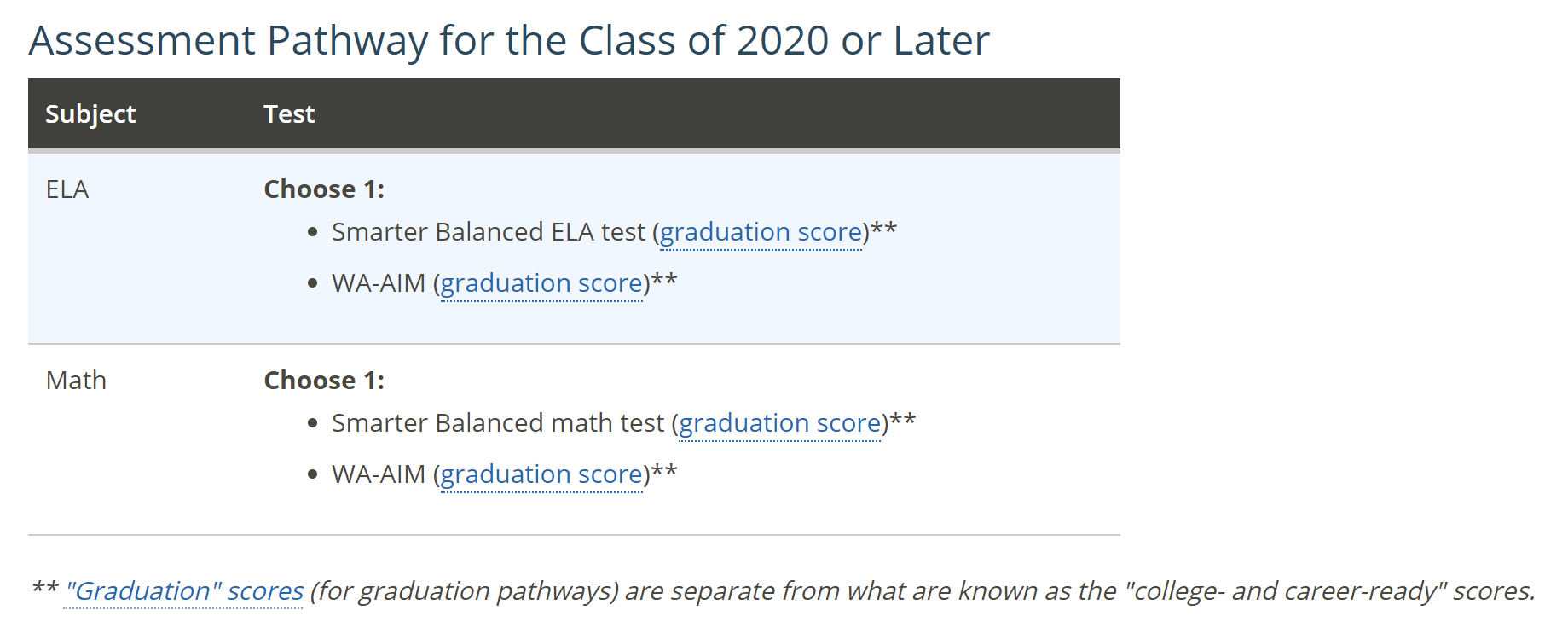Transition to High School and Beyond
Transitioning to high school for many students and parents can be like moving from Earth to another planet. High School has a different set of requirements and expectations and families must plan for this transition just as they would plan for life after high school.
This guide is intended to help students navigate this new world and begin planning. It is important to know that students must fulfill the graduation requirements that are in place when they first enter ninth grade.
Requirements to earn a high school diploma
To earn a diploma in Washington State, students must meet graduation requirements:
- Earn high school credits taking core and elective courses
- Pass state tests or an approved Graduation Pathway Option
- Complete a High School and Beyond Plan
Courses – what subjects will you have to take?
A variety of courses are required for graduation in the areas of English, Math, Science, Social Studies, the Arts, Health and Fitness, Career and Technical Education, and Electives. Graduation requirements depend on when students enter the ninth grade. The World Language requirement can be waived with Personal Pathway credits, but this is an entrance requirement for most colleges and universities.
Washington State History is a required course for graduation, so students who do not complete this course in middle school will need to take it in high school. Successful completion of a Washington State History course is noted on high school transcripts.
All CVA high school courses are online. We encourage middle school students to enroll in one or more online courses during their seventh and eighth grades to gain valuable experience with online courses. Even if students don't plan to attend CVA during their high school years, many high schools (and now colleges) require students to take a series of online courses.
Requirements and Credits
CVA offers one-semester and two-semester online courses. Students earn credits toward graduation based on the completion of each course. Students earn one-half credit for one-semester courses and one credit for two-semester courses that are completed with a passing grade. Students can earn one-half credit for two-semester courses depending on how far they were when the course ended, but students will still need to earn the required overall credit. One-semester courses that take longer than one semester to complete are still only worth one-half credit.
CVA requires the state minimum number of credits for graduation, but students are advised to maximize credits earned based on plans after high school. School districts can set graduation credit requirements beyond the state minimum, so students who transfer from CVA to another public school will need to inquire about graduation requirements to determine how many credits are required to earn a diploma in that school district.
Washington State Minimum Credit Requirements
The following chart shows the state-required minimum number of credits students need, by year of expected graduation (also known as “Class.”) A student’s Class is determined by the year he or she enters 9th grade. For example, a student who enters 9th grade in the fall of 2021 is the “Class of 2025.”

See more information here about WA State Graduation Requirements.
State Assessments
One of the pathways students can use to demonstrate post-secondary career or college readiness is passing the state assessments.

See more information here about State Testing.
Alternative Pathways to State Testing
CVA offers two alternative pathways to state testing requirements.
High School and Beyond Plan
The High School and Beyond Plan is a graduation requirement. This document is designed to help students think about their future and choose coursework that prepares them for their goals after high school.
Students can begin developing the plan in middle school by working with their parents and school staff to create a High School and Beyond Plan that is based on their own Personalized Pathway Requirement. Students continue to revise plans each year throughout high school as interests or goals change.
Selecting Courses in High School
Student plans following high school should be a primary consideration for determining the academic rigor of high school courses. Students who are furthering their education at the college or university level can expect admission officers to view their high school course schedule as a blueprint of the student's education. They are looking for a solid foundation of learning that students can build on in college.
To create a good foundation, students should take at least six solid academic classes every year. Starting with the basics in the freshman and sophomore years and moving to more advanced courses in the junior and senior years.
The following recommendations are standard for success in high school and beyond, whether students plan to attend a four-year or two-year college.
English (Language Arts)
Students need English classes every year. Traditional courses, such as American and English literature, help improve writing skills, reading comprehension, and vocabulary.
Math
Students need algebra and geometry for college entrance exams, college math classes and for many careers. Students should take these classes early so there is time to enroll in advanced science and math classes to demonstrate readiness for college-level work.
Most colleges look for students who have taken three years of math in high school. More competitive institutions require or recommend four years of math. Some of the courses offered are:
- Algebra I
- Algebra II
- Geometry
- Personal Finance
- Trigonometry
- Calculus
Science
Science teaches students to think analytically and apply theories to reality. Colleges want to see that students have taken two to three years of laboratory science classes. A good combination includes two semesters of each of the following sciences:
- Physical science
- Earth/Space science
- Biology
- Chemistry or physics
Social Studies
Students will better understand local and world events by studying the culture and history that has shaped them. Here is a suggested course plan:
- U.S. history
- U.S. government
- Civics
- Current World Issues
Foreign Languages
A solid foreign language study shows colleges that students are willing to stretch beyond the basics. Many colleges require at least two years of study in the same foreign language, and some prefer more. CVA offers Spanish.
The Arts
Research indicates that students who participate in the arts often do better in school and on standardized tests. The arts help students recognize patterns, discern differences and similarities, and exercise the mind in unique ways, often outside a traditional classroom setting. Two art credits are required but one credit can be replaced with a Personal Pathway credit.
Career and Technical Education
Career and Technical Education (CTE) gives high school students an opportunity to get a head start on preparing for college and careers through computer science courses along with business, culinary arts, and workplace experience.
Electives
Electives are courses of your choice beyond the required credits in course areas to fulfill the total credit requirements for graduation.
Graduation Toolkit
A valuable resource for you is the Graduation Toolkit developed by the State of Washington Office of Superintendent of Public Instruction:
College Planning Resources
It is never too early to begin planning for college. A valuable year-by-year guide for students and parents to prepare for college can be found at Petersons.com.